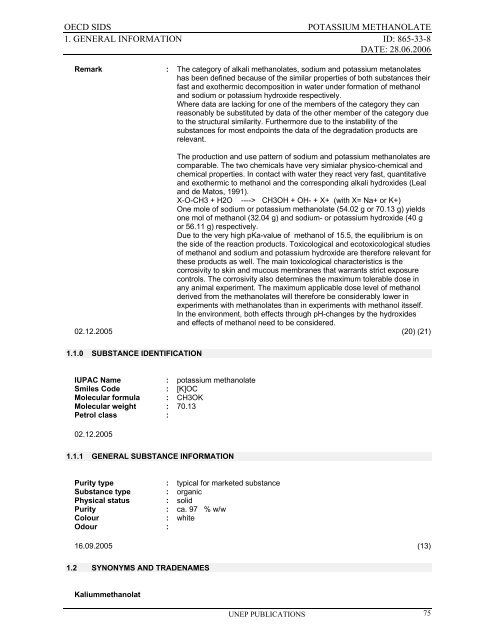Sodium methanolate - ipcs inchem
Sodium methanolate - ipcs inchem
Sodium methanolate - ipcs inchem
You also want an ePaper? Increase the reach of your titles
YUMPU automatically turns print PDFs into web optimized ePapers that Google loves.
OECD SIDS<br />
POTASSIUM METHANOLATE<br />
1. GENERAL INFORMATION ID: 865-33-8<br />
DATE: 28.06.2006<br />
Remark : The category of alkali <strong>methanolate</strong>s, sodium and potassium metanolates<br />
has been defined because of the similar properties of both substances their<br />
fast and exothermic decomposition in water under formation of methanol<br />
and sodium or potassium hydroxide respectively.<br />
Where data are lacking for one of the members of the category they can<br />
reasonably be substituted by data of the other member of the category due<br />
to the structural similarity. Furthermore due to the instability of the<br />
substances for most endpoints the data of the degradation products are<br />
relevant.<br />
The production and use pattern of sodium and potassium <strong>methanolate</strong>s are<br />
comparable. The two chemicals have very simialar physico-chemical and<br />
chemical properties. In contact with water they react very fast, quantitative<br />
and exothermic to methanol and the corresponding alkali hydroxides (Leal<br />
and de Matos, 1991).<br />
X-O-CH3 + H2O ----> CH3OH + OH- + X+ (with X= Na+ or K+)<br />
One mole of sodium or potassium <strong>methanolate</strong> (54.02 g or 70.13 g) yields<br />
one mol of methanol (32.04 g) and sodium- or potassium hydroxide (40 g<br />
or 56.11 g) respectively.<br />
Due to the very high pKa-value of methanol of 15.5, the equilibrium is on<br />
the side of the reaction products. Toxicological and ecotoxicological studies<br />
of methanol and sodium and potassium hydroxide are therefore relevant for<br />
these products as well. The main toxicological characteristics is the<br />
corrosivity to skin and mucous membranes that warrants strict exposure<br />
controls. The corrosivity also determines the maximum tolerable dose in<br />
any animal experiment. The maximum applicable dose level of methanol<br />
derived from the <strong>methanolate</strong>s will therefore be considerably lower in<br />
experiments with <strong>methanolate</strong>s than in experiments with methanol itsself.<br />
In the environment, both effects through pH-changes by the hydroxides<br />
and effects of methanol need to be considered.<br />
02.12.2005 (20) (21)<br />
1.1.0 SUBSTANCE IDENTIFICATION<br />
IUPAC Name : potassium <strong>methanolate</strong><br />
Smiles Code : [K]OC<br />
Molecular formula : CH3OK<br />
Molecular weight : 70.13<br />
Petrol class :<br />
02.12.2005<br />
1.1.1 GENERAL SUBSTANCE INFORMATION<br />
Purity type : typical for marketed substance<br />
Substance type : organic<br />
Physical status : solid<br />
Purity : ca. 97 % w/w<br />
Colour : white<br />
Odour :<br />
16.09.2005 (13)<br />
1.2 SYNONYMS AND TRADENAMES<br />
Kaliummethanolat<br />
UNEP PUBLICATIONS 75
















